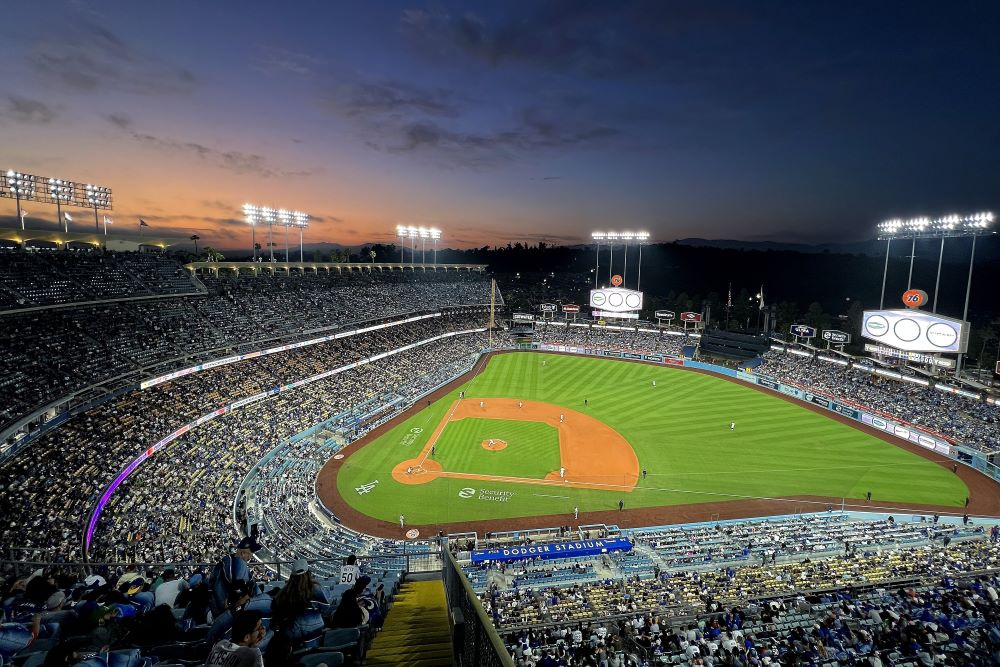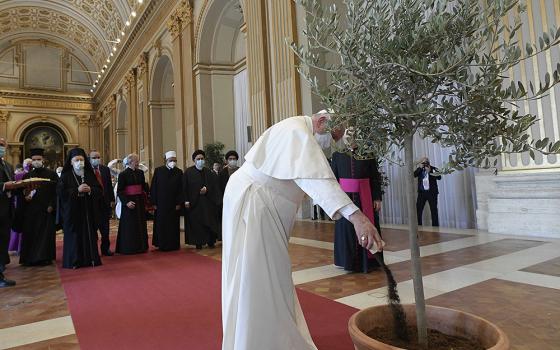
Los Angeles Dodgers pitcher Fernando Valenzuela, who died Oct. 22, celebrates after the Dodgers won the National League title over the Expos Oct. 19, 1981, in Montreal. Valenzuela, the Mexican-born Dodgers phenom, taped images of La Virgen de Guadalupe and El Santo Niño in his team locker. (NCR graphic/Los Angeles Times)
When Los Angeles Dodgers legend Fernando Valenzuela died Oct. 22 at just 63, my employer, the Los Angeles Times, quickly sprung into action.
Once we confirmed his passing, the Times posted online an obituary by deputy sports editor Ed Guzmán. Times sports columnists Bill Plaschke and Dylan Hernández penned appreciations. Plaschke and I appeared in a video recounting Valenzuela's importance to Los Angeles, Latinos and baseball. I contributed my own columna. Together, we offered a quilt that stitched together Valenzuela's remarkable story.
Born in a tiny town in the Mexican state of Sonora. Discovered after a Dodgers scout saw him playing in Mexico's top baseball league. Made an early splash in 1980 as a September call-up, then captured the eyes and heart of the United States and Mexico the following year when he won the Rookie of the Year and Cy Young awards at just 20 years old. Helped the Blue Crew to a World Series win against their archrivals, the New York Yankees, for their first championship in 16 years.
Two days after those articles posted, the Times republished them in our print edition, which I bought to add to my stack of memorable front pages. The photo that we ran above the fold was perfect — a black-and-white shot of a smiling Valenzuela during that magical 1981 season, which many simply refer to as Fernandomania.
The Dodgers had just beaten the Montreal Expos to clinch the National League title, and Valenzuela is partying in the clubhouse. We see peak Fernando: big eyes, tousled, bushy dark hair. Wide grin. Dark skin. A proud Mexican. He's holding a magnum of champagne with his right hand; his left hand holds onto a beam emblazoned with his jersey number, 34.
I smiled at the image, but didn't think much more of it. Leave it to my brother, a diehard Dodger fan, to send the photo to our sibling group text thread and put it in a completely different context.
"In his locker La Virgen de Guadalupe and El Santo Niño de Atocha," he wrote. My sisters immediately texted heart emojis. I stared at the image again, now flabbergasted and ashamed. Though small and a bit lost in the overexposed pictures, votive cards of each were taped right next to the 34.

Dodger Stadium in Los Angeles is seen May 16, 2023. The legendary Mexican-born LA Dodgers player died Oct. 22 at 63. (OSV News/Gary A. Vasquez-USA Today Sports via Reuters)
How on earth did I miss those details?
They are my two favorite apparitions of the Virgin Mary and the infant Jesus — the brown-skinned Madonna that appeared to San Juan Diego in 1531 in modern-day Mexico City, and a baby Christ who offered succor to Catholic prisoners during Spain's Moorish era. They are perhaps the two most beloved icons of Catholic Mexico, with shrines in Mexico City and in my parents' home state of Zacatecas. They are mainstays of Mexican households — immigrant and not — across the United States.
And there they were, in the locker space of perhaps the most prominent Mexican athlete ever, at the height of his fame.
Fernando Valenzuela was a private man, so I can't say with any certainty how important Catholicism was to him in his later years. He did not wear his faith on his sleeve like Vin Scully, the legendary Dodgers broadcaster who served as a lector for Masses held at Dodger Stadium organized by Catholic Athletes for Christ. Scully even recorded a two-CD album of him reciting the rosary.
But the photo of Fernando with la Virgen and Santo Niño de Atocha further confirmed my belief that Valenzuela was as biblical a tale in baseball as we'll ever see.
Like John the Baptist, he was a voice who emerged from the wilderness, born into a family of 12 in a house with no running water.
Like King David, Valenzuela was a humble toiler before he came into his kingdom — one of the most powerful franchises in American professional sports in the latter's case. The Irish Catholic O'Malley family that owned the Dodgers saw the young Mexican immigrant as their Moses, someone who would lead LA's growing Latino population to root for the Dodgers.
The crowds that came to watch him play in 1981 and beyond, both at home and on the road, recalls Mark 3:8, which states in part, "a great multitude, when they had heard what great things he did, came unto him." Fans mimicked Valenzuela's delivery, which resembled the sign of the cross: glove first at the chest, raised up while looking at heaven then brought down as the ball held in his left hand yanked back then swept across his body to strike out overmatched opponents.
Valenzuela so miraculous that he even largely absolved the Dodgers of their original LA sin: building their stadium on land that once hosted three Mexican American barrios that the city of Los Angeles leveled to make way for a public housing project that never materialized. But a decade after Fernandomania, Valenzuela became a prophet in his own land after the Dodgers released him just days before Opening Day, deeming him washed up. His fans, however, never forsook him, and he continued to fill stands while bouncing around the big leagues until finally retiring in 1997.
Advertisement
The night of his passing, my social media feeds filled with friends recounting their Valenzuela moments; a lucky few posted photos of them with him throughout the decades. Others posted prayer cards of votive candles of St. Jude Thaddeus, his face and crook replaced with Valenzuela's face and a baseball glove. It was a tongue-in-cheek homage based on reality: Those who had a chance to see Valenzuela play know it was an encounter with the divine.
The push to turn Valenzuela into baseball's version of a saint — induction into the Hall of Fame — will hopefully, finally happen in the wake of his death. His overall career turned out to be slightly above average — the Dodgers sadly worked his arm into a nub. But we don't revere saints solely because of the feats they accomplished during their lives; what they stood for is what ultimately inspires us. Grace in the face of hardship. A call to witness. A demand that we all do better in our lives.
That was Fernando Valenzuela. Que descanse en paz, Toro.





